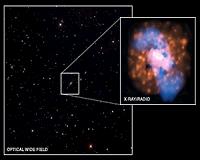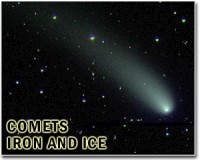|
 Fermilab Experiments Narrow Allowed Mass Range For Higgs Boson
Fermilab Experiments Narrow Allowed Mass Range For Higgs BosonBatavia IL (SPX) Jul 27, 2010 New constraints on the elusive Higgs particle are more stringent than ever before. Scientists of the CDF and DZero collider experiments at the U.S. Department of Energy's Fermilab revealed their latest Higgs search results at the International Conference on High Energy Physics, held in Paris from July 22-28. Their results rule out a significant fraction of the allowed mass range established by earlier experiments. The Fermilab experiments now exclude a Higgs particle with a mass between 158 and 17 ... read more |
. |
|
|
Free Space, Earth, Energy And Military Newsletters - Delivered Daily |
| . | . |
| .. |
Japan plans space probe to Mercury Tokyo (UPI) Jul 22, 2010
Tokyo (UPI) Jul 22, 2010 Japan says it is planning a space mission to Mercury with a spacecraft specially equipped with mirrors to combat the planet's intense heat. The Japan Aerospace Exploration Agency believes the mirrors will help the probe to survive temperatures of up to 842 degrees on the surface of the planet, The Daily Telegraph reported. By reflecting the intense heat of the sun, the temperatur ... more Russian Aerospace Company To Send Mission To Mercury  Farnborough, UK (SPX) Jul 23, 2010
Farnborough, UK (SPX) Jul 23, 2010Russian NPO Lavochkin intends to send an interplanetary research mission to Mercury in 4-5 years, Lavochkin's deputy general designer said at the Farnborough International Airshow 2010. "[The mission will consist of] a flight to Mercury and a landing on its surface," Maxim Martynov said. "We assume that the device will be a modified Phobos-Grunt satellite." He added that the NP ... more Detector Technology Could Help NASA Find Earth-Like Exoplanets  Rochester NY (SPX) Jul 23, 2010
Rochester NY (SPX) Jul 23, 2010The hunt is on for Earth-like planets outside of our solar system. Since the 1990s, astronomers have detected more than 450 extrasolar planets - mostly large Jupiter-sized bodies - around nearby stars. Advances in technology are fueling the quest to find smaller, rocky planets resembling Earth and, possibly, evidence of life. Rochester Institute of Technology scientist Don Figer is develop ... more |
.. |
 Black Hole Jerked Around Twice  'Sample return' space missions examined  Instant online solar energy quotes Solar Energy Solutions from ABC Solar |
.. |
|
|
Free Space, Earth, Energy And Military Newsletters - Delivered Daily |
|
|
. |
 Astronomers Find A 300 Solar Mass Star
Astronomers Find A 300 Solar Mass StarSheffield, UK (SPX) Jul 22, 2010 Using a combination of instruments on ESO's Very Large Telescope, a UK-led international team of astronomers have discovered the most massive stars to date, one which at birth had more than 300 times the mass of the Sun, twice as much as the currently accepted limit. The existence of these monsters - millions of times more luminous than the Sun, losing mass through very powerful winds - may provide an answer to the question "how massive can stars be?" The new results appear in a paper in the journ ... read more |
| The contents herein, unless otherwise known to be public domain, are Copyright 1995-2010 - SpaceDaily. AFP and UPI Wire Stories are copyright Agence France-Presse and United Press International. ESA Portal Reports are copyright European Space Agency. All NASA sourced material is public domain. Additional copyrights may apply in whole or part to other bona fide parties. Advertising does not imply endorsement, agreement or approval of any opinions, statements or information provided by SpaceDaily on any web page published or hosted by SpaceDaily. Privacy statement |
| Previous Issues | Jul 26 | Jul 23 | Jul 22 | Jul 21 | Jul 20 |